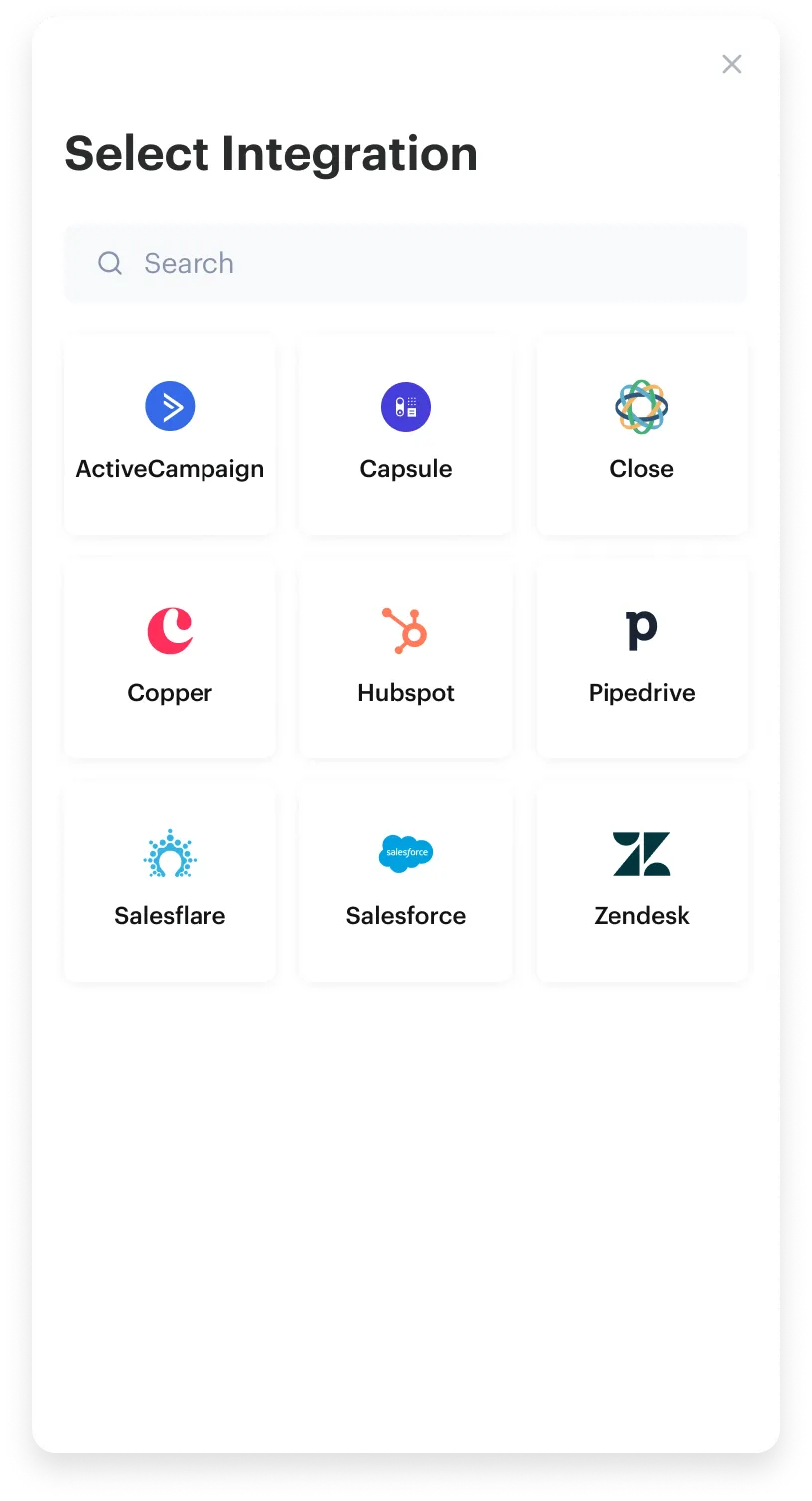Integrate Salesforce with your product—along with any other CRM application
Connect your product to all the applications your customers use via Merge's Unified API to close more deals, retain customers, and expand to new markets








Sync Salesforce data
FAQ on integrating with Salesforce API
How does Merge interact with Salesforce's API?
Merge accesses endpoints related to accounts, leads, contacts, opportunities, and tasks.
More specifically, Merge sends direct API requests to Salesforce and normalizes this data into its Common Models. This ensures that your application's data is up-to-date and accessible in a standardized format across different integrations.
Learn more about the API endpoints Merge interacts with.
How often does Merge sync Salesforce data?
Merge’s sync frequencies vary depending on the Common Model you’re using and the sync frequency you set (Daily, Standard, High, and Highest). That said, Merge can typically support anything from a 5 minute to a daily sync frequency.
You can also resync data outside of these intervals via Merge’s Force Resync endpoint, and you can sync data in real-time by leveraging Merge’s Automatic Webhooks feature.
Learn more about Merge’s sync frequencies for Salesforce.
Does Merge support other CRM integrations?
Merge currently supports 20 additional CRM integrations. These include popular platforms, such as HubSpot, Zoho CRM, Pipedrive, and Microsoft Dynamics 365 Sales.
Moreover, you can access all of these integrations with ease; simply build to Merge's CRM Unified API to add all 21 CRM integrations to your product.
Uncover all of the CRM integrations Merge supports.
What are some use cases for Merge’s Salesforce integration?
The use cases largely depend on the type of product you provide. That said, here are some use cases:
- If you offer a financial planning tool, you can add closed-won and open opportunities from customers’ instances of Salesforce to your product to help users forecast revenue and analyze different financial scenarios
- If you offer a speech analytics tool for field sales, you can sync appointment, account, product, order data and more from a customer’s Salesforce instance and add it to the associated call recording. This allows sales reps and their managers to quickly and easily understand the outcome from a sales recording
- If you offer a sales automation solution, you can ingest customers’ closed-won and closed-lost opportunity data from Salesforce and feed it to your machine learning model. From there, your model can generate recommendations on the best accounts to sell to
How long does it take my customers to set up a Salesforce integration?
Integrating Salesforce through Merge typically takes a few minutes to set up using Merge Link, which handles the authentication and initial configuration steps for end users. Once Salesforce is linked, data is automatically synced and normalized into Merge's Common Data Models.
As with other CRM integrations (such as HubSpot and Zoho), the process is designed to be easy for your customers, as they’ll have clearly laid-out instructions for completing the authentication flow.
Learn more about Merge Link.
New Year's Day - 1/1/2024Memorial Day - 5/27/20244th of July - 7/4/2024Labor Day - 9/2/2024Thanksgiving Day - 11/28/2024Day after Thanksgiving - 11/29/2024Christmas Eve - 12/24/2024Christmas Day - 12/25/2024

Trusted to power integrations at
























Make integrations your competitive advantage
More sales, less code, fewer headaches
Focus on your core product
Stop diverting your engineers to yet another integration and let them get back to work.
Give customer success a break
Manage your simplified integration issues in a single pane. No therapist required.
Stop losing sales due to integrations
Launch integrations in days, not quarters. Your sales team will thank you.
.png)

Integration authentication that feels like magic
Merge seamlessly manages authentication and authorization on behalf of your customers.
Offer account linking and permission controls to your users with Link for a customizable frontend or with Magic Link for URL-based authorization
The toolkit for all your integration needs
We make integrations painless with accessible API design, dead-simple SDKs, and beautiful documentation that we agonize over.
1from merge import Merge
2
3client = Merge(
4 account_token="YOUR_ACCOUNT_TOKEN",
5 api_key="YOUR_API_KEY",
6)
7client.hris.employees.list()import { MergeClient, Merge } from '@mergeapi/merge-node-client';
const merge = new MergeClient({
apiKey: 'YOUR_API_KEY',
accountToken: 'YOUR_ACCOUNT_TOKEN',
});
employee = await merge.hris.employees.list()
ApiClient.instance.authentications.tokenAuth = {
type: 'bearer',
accessToken: 'API_KEY',
};
new EmployeesApi().employeesList('ACCOUNT_TOKEN', {}, (data) => {
console.log(data);
});import (
"context"
"fmt"
merge "github.com/fern-api/merge-go"
mergeclient "github.com/fern-api/merge-go/client"
"github.com/fern-api/merge-go/hris"
)
client := mergeclient.NewClient(
mergeclient.ClientWithAuthApiKey("<YOUR_API_KEY>"),1ApiClient client = Configuration.getDefaultApiClient();
2client.setBasePath('https://api.merge.dev/api/ats/v1');
3ApiKeyAuth tokenAuth = client.getAuthentication('tokenAuth');
4tokenAuth.setApiKey('API_KEY');
5CandidatesApi apiInstance = new CandidatesApi(client);
6apiInstance.candidatesList('ACCOUNT_TOKEN');import com.merge.api.MergeApiClient;
import com.merge.api.resources.hris.employees.requests.EmployeesRetrieveRequest;
import com.merge.api.resources.hris.types.Employee;
MergeApiClient mergeClient = MergeApiClient.builder()
.accountToken("ACCOUNT_TOKEN")
.apiKey("API_KEY")
.build();
Employee employee = mergeClient.hris().employees().list(
EmployeesRetrieveRequest.builder()
.includeRemoteData(true)> {
"id": "0958cbc6-6040-430a-848e-aafacbadf4ae","remote_id": "19202938","employee_number": "2","company": "8d9fd929-436c-4fd4-a48b-0c61f68d6178","first_name": "Dirna","last_name": "Emanuel","display_full_name": "Dirna Emanuel",
"username": "dirnaemanuel",
"groups": [

Case study
%201%20(1).webp)
How Drata increases customer value and spends 80% less time managing integrations
Working with Merge’s Unified API and beautiful React component took less than a sprint to integrate, test, and release.
Supported CRM platforms
Make integrations your competitive advantage
Stay in touch to learn how Merge can unlock hundreds of integrations in days, not years


































